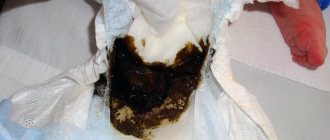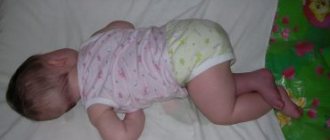What can cause stool upset?
When foamy stool occurs in a baby, it is not always accompanied by additional symptoms. The cause of the unpleasant phenomenon in the baby is related to the mother’s diet. Liquid stool with foam occurs due to the following factors:
- Early complementary feeding or mother consumed a new product.
- Taking medications.
- Imbalance in milk intake.
- Dysbacteriosis.
- Increased gas formation.
- Enzyme deficiency.
- Teething.
- Infectious diseases.
When consuming a new product that is difficult to digest, liquid, foamy, green stool appears. This is accompanied by anxiety in the child. If diarrhea continues for several days, then the product is excluded from the mother’s diet.
Attention! Mucous patches with foam are observed in the stool, which indicates an infectious lesion.
Many products contain coarse fiber and mother should know that for an undeveloped body this will be heavy food. In this case, disturbances in the functioning of digestion occur. Therefore, it is necessary to introduce an egg or other food into the diet only after six months. During this period, the baby's enzyme system will begin to strengthen. Breast milk helps maintain digestive function. If a mother begins to feed her baby before 5 months, this will interfere with the maturation of the newborn’s own enzymes.
In the first months, babies suffer from difficulties in the digestive tract and are tormented by colic. The pediatrician prescribes medications that help eliminate this problem. For example, as a result of taking Plantex, a baby may experience foamy diarrhea.
When the baby does not completely suck out breast milk, an accumulation of useful substances occurs. If the baby drinks only from the front part, the newborn receives less fat. This milk contains more proteins and water-soluble minerals. However, the child’s body does not absorb the substances and this becomes the cause of foamy stool.
Dysbacteriosis often causes loose, foamy stools in an infant. Diarrhea alternates with constipation, and stool has a sour smell. There are inclusions of pieces of poorly digested food in the stool. The color of the stool changes from light yellow to greenish. Treatment of dysbiosis in infants is not recommended. Doctors say that the problem will solve itself when the digestive tract develops sufficiently.
The appearance of gas formation causes diarrhea with foam. To eliminate the discomfort and symptoms in the baby, it is necessary to change the diet of the nursing mother. In addition, due to the underdevelopment of the digestive tract, infants experience enzyme deficiency. This happens after the introduction of complementary foods due to the body’s unpreparedness for a new product.
After 6 months, the baby's gums begin to become inflamed. This symbolizes teething. An additional symptom is the appearance of foamy diarrhea. To weed out dangerous causes, you need to pay attention to inclusions in stool. The stool should be clean, free of blood, mucus and not green in color. When negative signs appear, diarrhea indicates a bacterial or viral infection.
Signs and symptoms
Foamy stools in themselves are not a symptom of any disease. The baby’s first month is the most important and serious, since his body is still adapting to life outside the womb, so such stool is a completely natural reaction to breast milk, or to foods eaten by the mother. In case of regular foamy stools, the mother should review her diet and, if necessary, keep a food diary to avoid bowel movements of this nature.
Advice! Before throwing away your used diaper, examine your bowel movements. They can tell you a lot about your child's health.
If the baby eats formula, then foamy stool indicates that this formula is not suitable for the baby’s digestive system and it needs to be changed. Another factor in foamy stool is sucking on a pacifier or water bottle.
But one of the main causes of foamy stools is improper milk intake (imbalance). This happens in cases where the baby eats up mainly foremilk, which contains a large amount of useful vitamins, substances and carbohydrates needed for babies - lactose. To digest lactose, lactase is required, which is produced independently by the young body. The baby receives additional lactase by consuming hindmilk, which he sometimes does not have time to get to. This is where nutritional deficiency occurs - lactose is not processed properly and therefore the baby experiences colic, abdominal pain, and foamy discharge.
Read also:
When should you express milk after breastfeeding?
If the stool smells sour, this indicates lactose deficiency, and if the color of the stool is dark, this indicates malnutrition.
| Causes that do not require medical intervention | Reasons requiring the use of medications after mandatory consultation with a doctor |
| Incorrect diet of the mother, the reaction of the baby’s body to the product eaten, including the mother’s consumption of cow’s milk. | An intestinal infection is accompanied not only by foamy stools, but also by vomiting, fever, and lack of appetite. |
| Complementary feeding too early, or complementary feeding that was introduced incorrectly. | Staphylococcus, which is accompanied by symptoms of infection of the body. |
| The body's reaction to infant formula. | Lactase deficiency, which occurs if the baby consumes primarily foremilk from the mother's breast. This condition is accompanied by colic and usually goes away by the second month of life. Doctors may prescribe artificial lactase, but in most cases, foamy stools will go away on their own. |
| If the mother is being treated with medications. It is also important to pay attention to what medications you are giving your baby. Medicines that cause foaming may include colic medications. | Deficiency of enzymes such as isamaltase and sucrase. |
| Transient dysbiosis, which is often observed in infants, goes away on its own after the body adapts and does not require the intervention of drugs. | |
| Malnutrition can also be accompanied by foamy stools, but the feces are still dark in color. | |
| Colic, increased gas formation. |
What to do if a baby has foamy stools during breastfeeding?
If foamy stool appears in a breastfed newborn, then monitor its further condition. The occurrence of additional symptoms in the form of general malaise and inclusions in feces indicates the progression of the disease. The mother should follow a diet and put the baby to the breast correctly.
Baby hygiene is considered an important preventive measure, but the mother also needs to take care of herself. Clean and wash children's accessories in a timely manner. To prevent viruses and bacteria from entering the baby’s body, all toys and other objects with which contact occurs are washed with hot water. If diarrhea appears only with foam, then there is no need to worry. In case of deviations, consult a pediatrician.
Types of foamy stools
Normally, babies' bowel movements are mushy and have a yellow tint. In order to determine what foamy stool looks like in a breastfed newborn, it is better to visit a specialist. The pediatrician will more accurately explain what may be causing the disorders, evaluate the smell and consistency of stool, and detect the presence of blood streaks or mucous impurities.
Such symptoms will help the doctor more clearly determine the diagnosis, conduct a high-quality diagnosis and select a treatment method. In most cases, foamy stools are liquefied. If there is not much foam, the stool is mushy, and the symptom appears once a week, this can be considered as normal.
In many cases, studying the color and consistency of the baby’s stool helps to independently carry out the initial diagnosis. Against the background of the appearance of foam in it, the shade changes and a specific smell appears. And such changes are caused by various reasons.
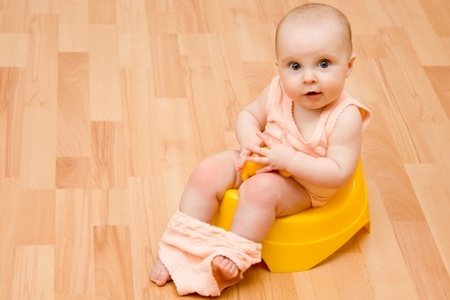
The color of a baby's stool can tell a lot about the baby's health.
Light and liquid
Normally, the color of feces in infants is yellow-brown. The substance stercobilin, which is a pigment, is responsible for color. Also, what shade the stool may be colored depends on the set of foods consumed the day before by the nursing mother. If a woman eats a lot of plant foods and regularly drinks cow's milk, loose, foamy stools in a breastfed baby are not uncommon.
Green
If a breastfed baby has green, foamy stool with a pungent odor, this is a sign of an improper feeding process. In this case, the balance of milk being received by the baby from the anterior and posterior chambers is disrupted. When a baby does not receive enough substances contained in hind or fore milk, disruptions occur in the digestive system, leading to changes in the color and consistency of stool.
The anterior portion contains more water and less fat, so frothy greenish stool in infants is often called “hungry”, because. the baby only manages to quench his thirst, but is not fully satisfied. To eliminate the problem, you should contact a specialist and adjust the feeding process. The baby needs to be latched to the breast for a long time so that he has time to receive not only fore milk, but also hind milk (which contains more fat and nutrients). It is also not recommended to place the baby on one or the other breast during feeding.
Yellow chair
Transient dysbacteriosis is a disease characteristic of infants up to six months and occurs against the background of foamy yellow stool. You can protect your baby from this borderline state by regular breastfeeding - mother's milk contains a lot of immunoglobulins. Thanks to them, the baby’s immunity and intestines become protected.

A newborn baby has a sterile intestine, and it begins to be populated with beneficial microorganisms and bacteria as it passes through the birth canal. The digestive system has a hard time adapting, causing the intestines to become stressed and react by producing yellowish, foamy stools. Usually this condition is accompanied by little weight gain and requires a visit to the doctor.
Often the cause of this condition is lactase deficiency, when the baby’s digestive system does not have enough enzymes to break down milk. If a nursing mother consumes a lot of dairy products, the fragile stomach is not able to cope with the load, which is why blood streaks and foam appear in the stool.
Less commonly, congenital dysbiosis is the cause of bloody spots in foamy stools. This pathology is very difficult to treat and the child has to constantly be given medications that maintain the intestinal microflora in a normal state.
The appearance of mucus impurities in foamy stool is often caused by taking inappropriate medications or long-term use of medications. But the symptoms are more likely to indicate the development of an intestinal infection. If, against the background of mucus and foam in the stool, the baby’s temperature has risen, and the condition does not improve within 24 hours, it is better not to delay a visit to the doctor.
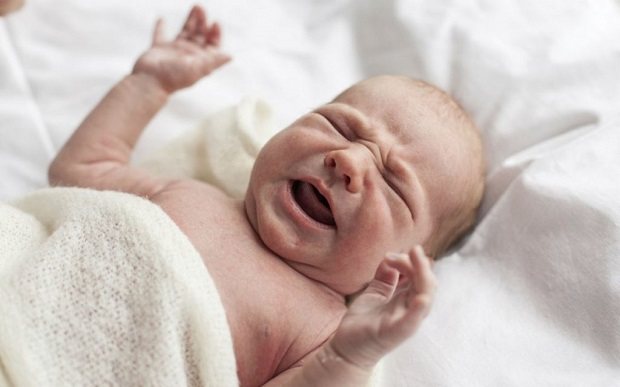
If, along with changes in the color of the baby’s stool, his behavior changes and the temperature rises, then this is a reason to consult a doctor
Mom's nutritional recommendations
After discharge from the maternity hospital, the mother needs to keep an observation diary. This will help identify which product is causing the diarrhea and remove it from the diet. Doctors advise adhering to the following rules:
- follow a special diet;
- Divide meals into 5 times during the day;
- eat meals in small portions;
- do not eat heavy food;
- fatty, spicy and fried foods are excluded;
- Constantly replenish your water balance.
During breastfeeding, the mother's body is depleted. To maintain the protective function of the body in good shape, you need to eat more fruits and vegetables, which contain many vitamins. It is recommended to prepare low-fat dishes by pre-baking or serving boiled. It is allowed to consume fruits and vegetables that do not cause allergies. To produce more breast milk, mothers should drink a lot of water. Compote, green tea or fermented milk drinks are suitable for this. While breastfeeding, you should not drink coffee or cocoa.
Stool disorder during artificial feeding
Babies under 5 months have a hard time digesting proteins and fats. There are many of these components in mixtures. As a result of artificial feeding, the appearance of foamy stools in a newborn becomes more frequent. Other main reasons for formula feeding are:
When a baby is bottle-fed, a change in the manufacturer of the formula is considered a factor in the appearance of diarrhea with foam. An unpleasant symptom occurs due to food poisoning. When the first tooth erupts, diarrhea also appears. Along with diarrhea, a slight increase in temperature is observed. Sometimes lactose intolerance occurs in infants, which leads to loose stools.
In the first months, the child’s body is rebuilt. The occurrence of colds or infections requires the use of antibiotics. These medications disrupt the intestinal microflora, which leads to dysbiosis.
Causes of foamy feces
Until about six months, the intestinal microflora is very weak and can react to any external factors, causing the baby to have loose, foamy stools. This is considered a normal reaction of the body. But if the child stops gaining weight, becomes lethargic, is bothered by gas and frequent constipation, it is necessary to find the cause of these manifestations.
Derevyankina G.N., pediatrician, Children's Health Center DNA Clinic, Chelyabinsk
Foamy stools may appear if the mother consumes large quantities of sweets, dairy and flour. Ice cream, cakes and other confectionery products are not recommended for nursing mothers. The baby's health is in milk, so it is important to monitor the diet daily.
A diet for nursing mothers helps prevent not only foamy stools, diarrhea or constipation, but also allergies in children.
Allergic reaction to food enzymes
At 2 years old, a child may develop foamy stools due to intolerance to one of the components of the food consumed. The most common allergens are citrus fruits, walnuts and other various berries.
If the baby is breastfed, the reaction can be transmitted through the mother's milk.
You can read about the nutrition of a nursing mother in the first month, prohibited and permitted foods, in this article.
Very often, in children, the color and consistency of feces change due to mixtures or new foods introduced into the diet, or after taking certain medications, especially antibiotics.
The consistency and color of stool are normalized immediately after the allergen is identified and eliminated.
Lack of lactase

Breast milk contains lactose, the breakdown of which requires lactase. Its lack leads to rumbling in the stomach, bloating and pain.
Pathology is determined by watery marks on the diaper and foamy stool.
After taking the necessary measures and confirming the diagnosis, the attending physician prescribes mixtures that do not contain lactose (Nutrilon, Bebilak-FL). You can read about hypoallergenic mixtures here.
If the baby is breastfeeding, he should be fed only full-fat hind milk. A balanced diet and doctor’s recommendations lead to the resolution of the situation and normalization of the production of necessary enzymes.
Dysbacteriosis
Dysbacteriosis can be accompanied by both diarrhea and constipation. Sometimes even alternating them. In this case, you cannot stop breastfeeding; if you are artificially feeding, give preference to fermented milk formulas.
The attending physician must prescribe probiotics. Trying to cure a child on your own is not recommended. Incorrect therapy can lead to more serious consequences. If you follow all the doctor’s recommendations, your stool will return to normal in about two months.
At 3 years old, foamy stool in a child requires adherence to a strict diet containing cereals, fermented milk products and fresh vegetables.
Fermentative dyspepsia
The disease most often affects older children. The reasons may be an unbalanced diet, consumption of carbonated drinks. Legumes, cabbage and fruits in large quantities can also provoke foamy stools in a child.
Treatment requires adherence to a strict diet. It is allowed to eat meat, fish and cottage cheese.
Staphylococcal infection
This disease is considered very serious and is accompanied by foamy stools, indigestion, mucus in the stool, severe pain, vomiting and high fever. The stool may acquire a greenish tint, sometimes mixed with blood. What to do if a child has vomiting and diarrhea, but no fever, you can find out here.
At the first manifestations, you must call a doctor. After the tests are completed, comprehensive treatment is prescribed.
Bryunina M.R., pediatrician, “Clinic of Allergy and Pediatrics on the street. Chudinova", Ufa
It is very important not to stop breastfeeding if you have an intestinal infection. Milk will help the baby cope with the disease in a short time and restore the intestinal microflora.
Milk contains a huge number of white blood cells and antibodies that destroy harmful bacteria in the intestines.
In what cases is a doctor needed?
You need to seek help if diarrhea occurs more than 8 times during the day. Sometimes an unpleasant symptom appears 2 times within an hour. The norm of bowel movements is considered to be up to 10 times when breastfeeding, and up to 5 times while taking formula. It is necessary to call a doctor at home if the child’s signs of loose stools with foam are combined with the following symptoms:
- profuse vomiting;
- temperature rise to 38 0 C;
- loss of appetite;
- high-pitched scream for a long time;
- green or yellow stool;
- inclusions of mucus, blood and foreign bodies;
- increased gas formation;
- release of gases during bowel movements;
- unpleasant smell of stool;
- snot, general malaise and lethargy;
- redness of the skin in the butt area.
Treatment and help at home
Mom should not introduce complementary foods early. You need to choose the right baby formula without any flavoring additives. Among the folk remedies against colic, dill water is used. It is recommended to prepare fennel tea or replace the folk remedy with its pharmaceutical version - Plantex. Help at home depends on the cause of the bowel disorder. Only after consultation with a pediatrician is the correct treatment prescribed.
If foamy diarrhea occurs due to dysbiosis, then medications with prebiotics and probiotics are prescribed. These medications include:
- "Bifidumbacterin".
- "Bifiform Baby"
- "Enterol".
- "Hilak Forte" for children.
Sometimes the drugs further irritate the intestines, and the diarrhea does not stop. If an allergic reaction to medications occurs, you must stop using them. To treat lactose intolerance, you must stop breastfeeding for a while. Intolerance occurs as a result of taking the drug "Lactazar", which should be removed from the children's medicine cabinet. Diarrhea due to intestinal infection requires urgent hospitalization.
Drug treatment
Please note that under no circumstances should you self-treat your child without the approval of your pediatrician. Doctors usually resort to medications as a last resort. First, the pediatrician will advise you to adjust your diet, eliminating all forbidden foods that cause discomfort in the baby’s body.
Read also:
Causes of cracked nipples during breastfeeding
If doctors have diagnosed dysbacteriosis, then bifiform and bifidobacterin are prescribed. If the cause of foamy stool is a lack of lactase, medications containing it are prescribed. If foamy stools indicate an allergic reaction to foods eaten by the mother, the allergist will select the necessary diet plan and prescribe antihistamines and sorbents to remove toxins.
Intestinal infection poses a great danger, because in this case, the baby becomes dehydrated. Diarrhea with foam is accompanied by restlessness of the baby, lack of desire to eat, frequent bowel movements (almost every hour), yellow or green feces, bowel movements accompanied by a sharp pop and gas. With diarrhea, the baby, as in a healthy state, will have loose stools, but with the above symptoms. The doctor may prescribe Regidron or other medications that eliminate this condition.
Important! Before the doctor arrives, it is necessary to give the baby some water, because... With diarrhea, there is a large loss of water from the body.
Diet after illness
The mother’s diet, after the baby’s digestion has returned to normal, consists of foods that do not increase gas formation. The diet is not strict and includes mixed dishes. You should not eat legumes, cucumbers, bell peppers and cabbage. The disorder occurs after drinking cow's milk. Therefore, goat milk drink is often used. To replenish the water balance, the mother drinks clean water or compotes, teas. After illness, you should not drink carbonated drinks.
Important! When a child eats, during breastfeeding the baby must latch onto the nipple correctly. If you hear your baby smacking his lips, then after eating he will have colic and foamy stools.
When loose stools appear, the consistency and shade of the stool changes depending on the cause of the disorder. The occurrence of diarrhea with foam is not always a dangerous sign. The appearance of additional symptoms is considered a reason for concern for the mother. The frequency of intestinal disorders occurs the same in both breastfed and bottle-fed babies. Therefore, the provoking disease should be treated only after consultation with a pediatrician.

Almost all parents, especially when they have their first baby, are sensitive to any changes in his well-being, especially foamy stools in the baby. Lack of experience makes women worry about watery feces in the baby. However, such changes are not always evidence of diarrhea and danger. Therefore, it is important to have detailed information about why the baby has foamy stools, what needs to be done in such cases, and whether it is always necessary to contact a pediatrician.
Main causes
Foamy stools in infants can be caused by various reasons:
- non-compliance with diet by a nursing mother;
- development of intestinal infection;
- incorrect feeding regimen;
- allergic predisposition;
- lactase deficiency;
- disorders of the digestive system.
If the stool of a breastfed baby foams and becomes liquid, the reason may lie in an allergic predisposition. Together with mother's milk, the baby receives substances that can cause irritation of the digestive tract and intestines. To eliminate the problem, a woman just needs to determine which product causes her baby’s allergy and eliminate it.
Foam in the stool often appears when complementary foods are introduced incorrectly and untimely, when the baby is given foods that are not age-appropriate and irritate the baby’s delicate intestines. Infants under six months of age often experience gastrointestinal disorders after drinking cow's milk. Medicines that the mother takes or gives to the baby (even anti-bloating medications) can also trigger allergies and cause loose, foamy stools.

When breastfeeding, it is important for a woman to adhere to proper nutrition
When a baby has foamy stools and their color changes to green, you should not hesitate to visit the doctor. It is necessary to take tests for microflora disorders, infection with staphylococcus and other infectious agents.
The development of an infectious intestinal disease occurs against the background of severe symptoms:
- heat;
- nausea and vomiting;
- abdominal pain;
- increased frequency of bowel movements up to 10-20 times a day;
- lack of appetite.
Foamy stool with an admixture of foam, which has an unpleasant odor, also appears with the development of a staphylococcal infection with suppuration of wounds on the baby’s body, the growth of boils and inflammation of the mucous membranes. Therapy is selected by a pediatrician.
The appearance of foamy stools in infants is often caused by malfunctions of the digestive system. These include:
- dysbacteriosis - manifested by alternating constipation and diarrhea, foamy stool with a strong sour smell, a change in the shade of stool to too light and greenish;
- increased formation of gases - the condition can be eliminated by selecting a diet for a nursing mother, preventing bloating and colic;
- enzyme deficiency - a weakened digestive system, not ready for excessive loads, can react with foamy stools to sucrose, fructose, lactose, and the introduction of complementary foods.
As a result of malnutrition, when a baby does not receive enough formula or breast milk, a nutritional deficiency develops in his body. In such cases, the color of the stool becomes darker, and an admixture of foam appears in it.
As already mentioned, foamy stools also occur when there is an imbalance of milk from the anterior and posterior mammary chambers. When fed only with foremilk, the baby develops lactase deficiency, which is why liquefied feces with foam appear.
About Normal Baby Poop
Experienced mothers know that babies' poop is normally yellow. They have a specific smell and cannot be too thick. At the same time, the feces of a breastfed and bottle-fed baby are significantly different: in the first case, they have a more sour “aroma” and leave characteristic stains on the diapers.
As for artificially fed children, there may be more options for the shade of feces: light yellow, dark orange, brownish, bright yellow. It depends on the type of mixture. It also determines the smell of the newborn’s feces, their consistency, and the number of bowel movements per day. Infant formulas have a similar composition, but not identical. For example, an increased dose of iron in such a diet can turn the feces into a greenish tint. Typically, such mixtures are recommended for children under one year of age with diagnosed anemia.
It is worth noting that it is precisely those who are artificially fed who are more likely to have problems with constipation than with loose stools. Pediatricians call the norm that such babies have a bowel movement once a day.
Practice shows that adapted mixtures often have a fixing effect. While breast milk, depending on the woman’s nutritional type, can create the above problem. Foamy stools appear more often in breastfed babies. It might even be green. As for the daily number of bowel movements of such newborns, the norm may be 4-6 times and after each feeding.
Reasons for stool changes
There are many of them. Children's doctors identify the most common factors that provoke alarming changes. Here are the main reasons for foamy stool in infants:
- Allergy. It even occurs with breast milk. Let us remind you: the products consumed by the mother (all without exception) end up in it. However, not all such components of milk are normally perceived by the baby’s digestive system. When a child is prone to allergies, his gastrointestinal system reacts to similar products on the mother’s menu with a kind of protest - the baby poops foam. A similar reaction of the ventricle can be observed with the illiterate introduction of adult food (complementary foods). We are talking about introducing the baby to them too early or not following the principle of gradualness when introducing them.
- Medicines. Even medications allowed for such young patients can provoke a sharp deterioration in digestion. A manifestation of this is that the child has foam instead of feces. Also, the use of medications by the mother of the baby provokes a similar condition. Inexperienced lactating women, when they experience pain (dental, stomach), out of habit, grab medications from the home medicine cabinet, not taking into account that they quickly penetrate into their milk. Experience shows that even specially designed anti-colic medications for infants can cause foamy diarrhea in a child.
- Infections. Intestinal diseases quite often provoke the above problems if parents themselves ignore the rules of hygiene and do not pay due attention to sterility in keeping the baby. In such situations, not only does the child develop foam in the stool, but the body temperature rises sharply, colic occurs, and the child cries restlessly. Pediatric practice states that rotavirus in infants can also be the cause of watery, foamy stools. In the latter case, the feces become green. Infections can also cause digestive disorders during periods of teething in children of this age. This is always a painful process when babies try to scratch their sore gums and pull various dirty toys and objects into their mouths. Thus, infectious agents provoke foamy stool in an infant. In addition, salivation may increase and the child may experience irritability.
- Dysbacteriosis. It is not a common factor that a baby develops loose stools with foam. The disease is almost always accompanied by disruptions in the functioning of the child’s weak digestive system. A characteristic feature in this case is undigested food in the feces, weight loss with a good appetite. Children's doctors claim that in some newborns, transit dysbiosis can be a temporary phenomenon and does not require drug interventions or other auxiliary measures.
- Lactase deficiency is nothing more than the presence of a deficiency of a particular enzyme. Lactase is a substance that helps babies process food. They receive the enzyme through mother's milk. When a woman doesn’t have enough of it, her child’s feces take on a different, more unpleasant smell. Bubbles and foam are observed in the child's stool.
Causes of foamy diarrhea
Liquid, foamy stool may be due to a lack of the enzyme lactase , which is found in large quantities in hind breast milk.
If a nursing mother constantly changes breasts, offering the baby the right one, then the left one, the baby does not get enough to eat. The likelihood that the baby is not receiving enough hind milk increases greatly.
Liquid stool with foam in a newborn may be due to dysbiosis or a malfunction of the still weak digestive system .
Another reason for the appearance of loose, foamy stools is an allergy to the introduction of complementary foods . Then this process needs to be delayed for a couple of months until the digestive system is ready to accept unfamiliar enzymes.
For what reasons can thrush appear in a baby's mouth? How should the disease be treated? Now let's take a closer look at how diathesis in infants is treated. Doctors' advice.
Read about how healthy and tasty it is to prepare zucchini puree for babies in our article.
How to treat foamy stools in babies
When noticing that a child’s stool is foaming, what actions should his mother take? Don't panic is the main thing. After all, her nervousness is passed on to her child. You need to act consistently and competently. The best adviser in such cases will be breastfeeding specialists and children's doctors.
First of all, they will recommend getting tested. There is no need to guess what factor became the catalyst for the problem in a boy or girl. It is necessary to bring a diaper with fresh baby feces to the clinical laboratory. The test results will reveal the infection if the baby has it. Then the pediatrician will prescribe the correct, safe therapy and monitor the process. If an infection is detected, the doctor will prescribe drugs to the young patient to destroy it. These could be:
However, there may be other reasons for foam in a baby's stool. And bacterial culture will help to establish them. Such a study determines the composition of the intestinal microflora, identifies pathogenic bacteria, as well as the ratio of harmful and beneficial microorganisms. If there is a deficiency of the latter, pediatricians usually diagnose “dysbacteriosis” and prescribe special medications in the form of beneficial bacteria to young patients. Such medications may be:
- Acipol;
- Lactobacterin;
- Linux.
After a course of such drugs, the child’s stool with foam disappears, the stool returns to normal, and the child calms down. Another current recommendation is correcting nutrition, reducing single servings and reducing the time between feedings. This mode helps the baby’s ventricle more easily digest and assimilate incoming food.
Children's doctors emphasize: dehydration is the main danger of diarrhea and foamy feces. A deficiency of fluid in a child's body makes the child apathetic, weak, and lethargic. The consequences of dehydration are:
- retraction of the large fontanel;
- the appearance of rashes on the skin;
- cloudy urine;
- less frequent urination.
That is why it is important to compensate for lost fluid and supplement the child’s nutrition. Children's doctors advise doing this every 10-20 minutes. You can use the medication Regidron at the stage of identifying the cause of the problem. It is necessary to drink this liquid in a way convenient for the baby: from a spoon, from a bottle, or inject it with a syringe, having previously removed the needle.
How to Avoid Foamy Poo
Most responsible mothers worry when their baby's stool foams. But what they perceive as a danger signal is not always so. An experienced doctor will help confirm doubts or completely dispel them.
To avoid changes in the functioning of the child’s digestive system, regardless of the type of feeding, parents must strictly observe personal hygiene everywhere and not neglect to boil children’s dishes and toys. The recommendation is especially important during the period when the baby is teething and he puts dirty things into his mouth.
Lactating women need to realize that restrictions in their own diet are the basis for the baby’s calm, rapid adaptation of the ventricle to stable operation, and the absence of colic. You need to understand the list of prohibited foods and, at least until the child is three months old, exclude them from the menu altogether. We are talking about those that increase gas formation and can provoke allergic reactions. Ideally, nursing mothers should keep a food diary to make it convenient to track changes in the baby’s condition and find out what could have caused them.
As for infants on adapted formulas, the main recommendation is not to overfeed them. An abundance of food is not caring for the baby, but on the contrary, it is harmful to him. Mucus, foaminess of stools, their frequency, and digestive disorders indicate that the gastrointestinal tract system cannot cope with the load.
To prevent the above pathology, doctors advise not to rush to introduce your child to adult food. It should be administered to breastfeeding babies no earlier than five months of age and only if there is no allergy. You also need to remember about the gradual transition to adult food: start with a teaspoon and increase the volume of complementary foods daily by the same portion. The first can be vegetables or cereals.
We establish the cause - we eliminate the problem
Let's highlight the main reasons why a baby may have foamy stools, and decide how to help him.
Nutritional deficiencies
If the stool is dark in color, foamy, even watery, the body is most likely notifying you of a lack of nutrients. The solution to the problem will depend on what the baby eats.
If you are breastfeeding, you should remember that the average interval between meals is about 2 or 2.5 hours. At first and during lactation crises, a woman should feed her baby on demand. This helps to rebuild the body to produce more milk.
Proper feeding means that the baby fully grasps the nipple and the surrounding areola. There shouldn't be any smacking. When breastfeeding, you can only hear the baby swallowing a portion of milk. If all this has been done, and the baby still does not eat enough, the baby is supplemented with an adapted milk formula at one of the feedings.
As for babies on artificial feeding, the interval between them is from 3 to 3.5 hours. The longer period is explained by the fact that the mixture is richer and takes longer to digest.
Breast milk is so different
The composition of milk changes not only after childbirth (from colostrum to mature), but also during each feeding. At the beginning of a meal, the baby receives “foremilk.” It is intended to quench thirst and contains a very small percentage of fat. As suckling progresses, the concentration of fat increases, and the hindmilk is fattier and more nutritious, which is what gives a feeling of fullness.
When, for various reasons, a child does not get to the “hind” milk or receives it in insufficient quantities, this is reflected in his stool: it becomes foamy and watery. And if there is a sour smell, they talk about lactase deficiency. The fact is that for good absorption of the much-needed carbohydrate called lactose from milk, the enzyme lactase is needed. And lactase is exactly what is found in hind milk. It turns out that there is a lot of lactose and not enough lactase. Hence, intestinal disorders occur if hindmilk is not supplied in sufficient quantities.
What can you do? Try to apply the rule: one feeding - one breast, that is, feed the baby at one feeding only from one breast so that he exhausts all the reserves in it. When this does not help, an adjustment to obtain additional lactase is selected at a consultation with the pediatrician. Basically, by the second month of life this problem disappears.
Allergy to the introduction of complementary foods
This happens when complementary foods are introduced very early and with the wrong foods. The problem can be easily solved by adjusting the diet. Your doctor will tell you when it is best to introduce certain foods into your diet.
Reaction to medications
Breastfeeding mothers are not always able to avoid taking medications during breastfeeding, many of which can pass into breast milk. Needless to say: for a baby, such components can irritate the gastrointestinal tract and affect the consistency of stool.
Intestinal infection
The stool is loose and frequent, up to 12 times a day, green, foamy. Such a symptom always requires seeing a doctor. As a rule, body temperature rises to 38 OC or higher. Foamy stools are often observed with a staphylococcal infection, but it is never the leading symptom. The baby's condition in such cases also requires hospitalization.
Dysbacteriosis
There are many different controversies regarding this condition. However, the situation when undigested food remains and foamy discharge are visible in the stool does occur. All this goes away on its own as soon as the intestines adapt to the new system of work.
Increased gas formation
Foam in the stool of a month-old baby is observed with increased gas formation and intestinal colic. There is no universal method here, although there are many ways to alleviate the baby’s condition. Mom should reconsider her diet and take her diet more seriously during the first months of breastfeeding. It is advised not to consume cow's milk, even condensed milk.
Cause of foam in stool
- If the mother has eaten some new product, the baby’s stool becomes yellowish or even green, foam and even mucus appear in it. In this case, you need to monitor the newborn: if he becomes restless and the excrement does not become normal within 3-4 days, the mother will have to give up the new product.
- Fast feeding. It happens that the mother does not allow the baby to completely empty one breast, but immediately puts it on the other, which can also affect the color and consistency of the baby’s stool. The reason is that the newborn does not receive the so-called “hind” milk. This means the following:
- The baby receives foremilk immediately as soon as it is applied to the breast. Such food is rich in minerals and protein and has a bluish color;
- “hind” milk has a different consistency; it is thick, yellow in color, and contains a lot of fats and enzymes for breaking down lactose.
The ideal option for breastfeeding is one in which the baby receives the full volume of milk, since the “front” is absorbed less well, and the “back” is necessary for this process to take place. Undigested food is fully reflected in the quality of feces - it becomes foamy and changes color.
So what to do?
We saw that there are many reasons why foamy stool appears in infants, and they are often interrelated. If the child is cheerful and feels well, there is no reason to worry. Depending on the situation, you need to adjust your diet or your baby’s; Perhaps keep the baby at the breast longer and feed more often. In some cases, it would be a good idea to go to the pediatrician when the stool foams regularly and there are other suspicious symptoms. In any case, this problem is successfully solved.
What parents should do: 4 important steps
You need to act according to the situation and be sure to monitor the child’s condition.
- Remember preventive measures. They consist of simple and regular actions: personal hygiene of adults, hygiene of baby care, diet of a nursing mother, correct and timely complementary feeding, correct breastfeeding.
- Avoid self-medication. This is especially true for traditional methods of treatment and advice from mothers on various non-professional forums. Foamy stool in an infant may not pose any threat to a particular child. But after heated discussions on the forum, you can find in your baby all the diseases that medicine knows, except for puerperal fever.
- Consult your pediatrician. The doctor will examine the child and, if necessary, prescribe tests and treatment.
- Pass the necessary tests. First of all, you will need a general clinical blood test, tests for lactase deficiency and dysbacteriosis.
For an extensive examination, a consultation with a pediatric gastroenterologist is necessary, who will help identify the causes of foamy stools, prescribe treatment if necessary, or reassure parents and convince them that there is no danger.
Foamy stool in a child is most often associated with fermentation processes in the intestines caused by digestive disorders and improper diet of the nursing mother or baby. These obvious causes need to be eliminated. If foam remains in the stool for a long time, it is necessary to undergo additional examination.
The baby’s digestive system in the first months does not always fully cope with its functions due to a lack of enzymes, and even small errors in the child’s nutrition affect the consistency and color of stool.
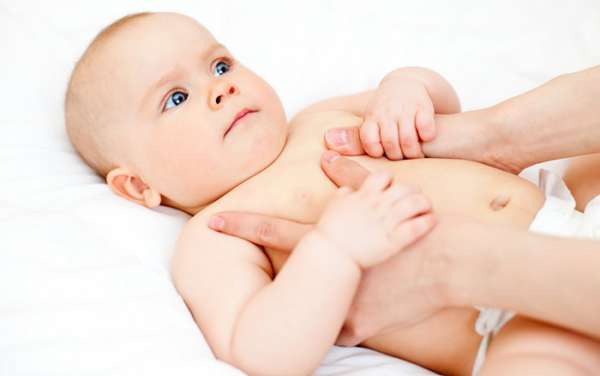
Common problems include foamy stools in infants. Its occurrence does not necessarily indicate serious problems with the baby’s health, but in combination with other clinical manifestations (change in stool color, elevated body temperature, lethargy or increased excitability of the child) it can be a symptom of an acute disease.

